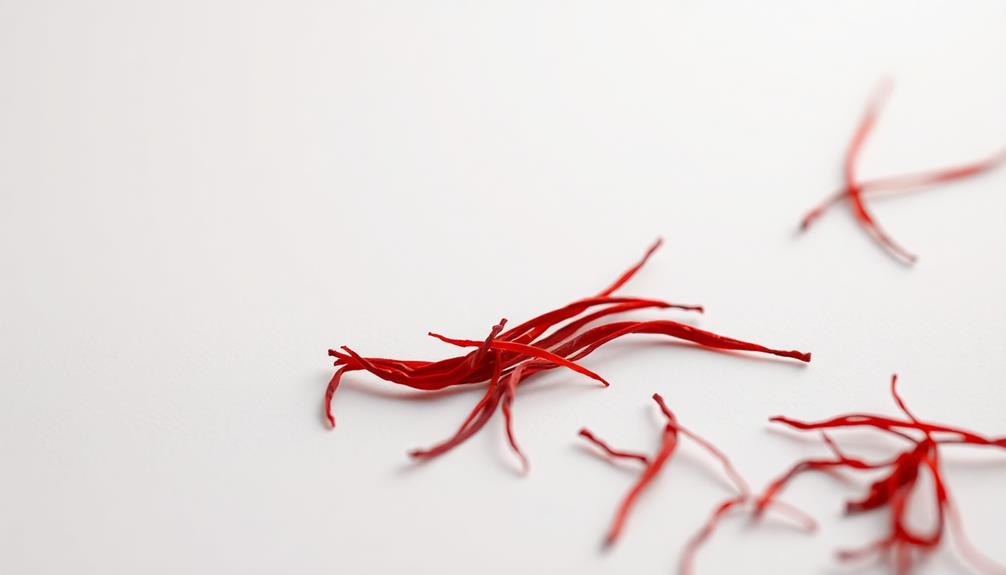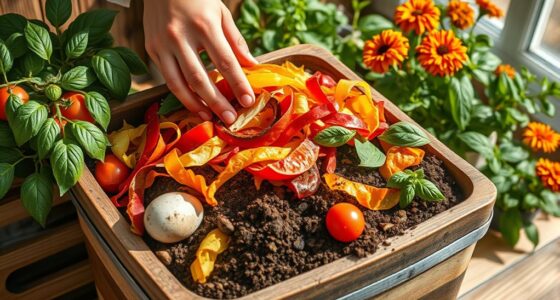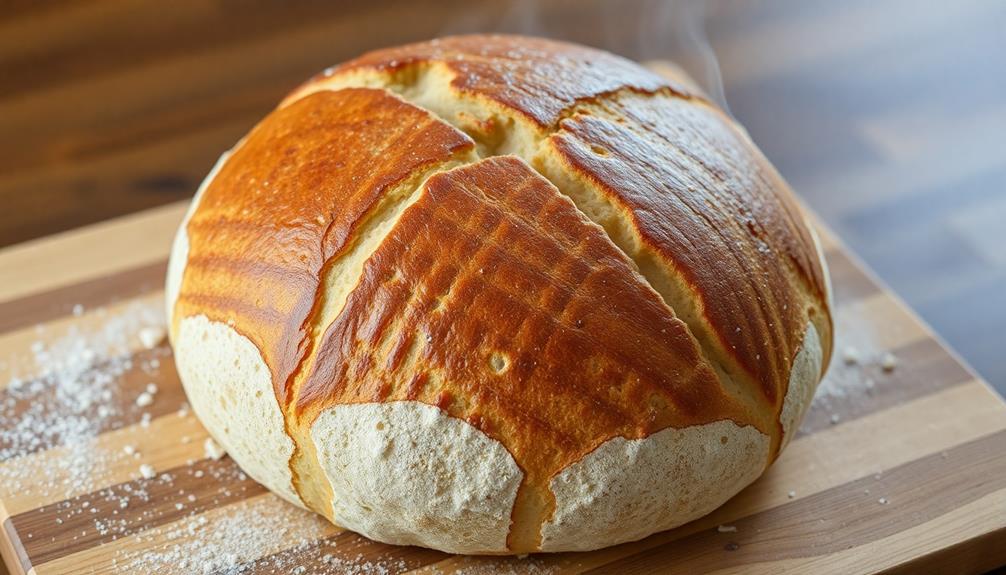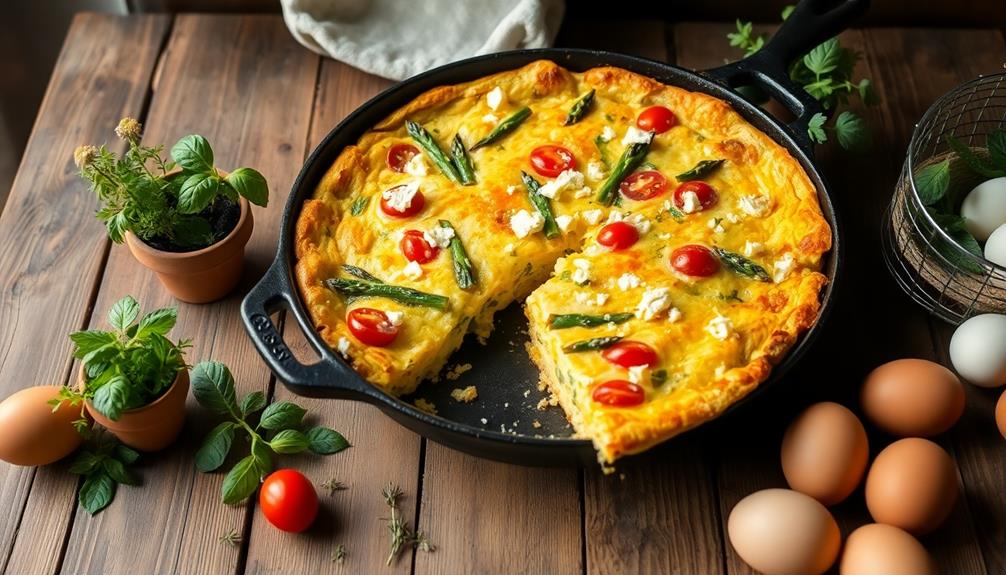Saffron, the world's most expensive spice, originates from ancient Persia and boasts a vibrant color, unique flavor, and alluring aroma that can transform ordinary dishes into culinary masterpieces. Its labor-intensive harvesting process, which requires up to 150 flowers to yield just one gram, contributes to its exclusivity and high market price. Yet, a little saffron goes a long way, infusing essence during cooking and enhancing aromas and tastes across a wide range of culinary creations. Discover the rich history and versatile uses of this prized ingredient as you continue exploring the world of saffron.
Key Takeaways
- Saffron is the world's most expensive spice, with its high price attributed to the labor-intensive harvesting process, where up to 150 flowers are required to yield just one gram.
- The vibrant color, unique flavor, and delicate aroma of saffron make it a prized ingredient in various culinary traditions, including Persian and French cuisines.
- Saffron is versatile, enhancing both savory and sweet dishes, and can significantly improve the overall taste and appearance of a meal with just a small amount.
- Proper preparation, such as steeping roasted saffron in hot water, is essential to extract the full depth of flavor and color from this delicate spice.
- While saffron's high cost may deter some, it is considered a worthwhile investment for cooking enthusiasts seeking to elevate their culinary skills and create extraordinary dishes.
History
Saffron, one of the world's most precious spices, boasts a rich and storied history spanning centuries. Its origins can be traced back to ancient Persia, where it was highly prized for its vibrant color, unique flavor, and purported medicinal properties.
From there, the cultivation of saffron spread throughout the Mediterranean region, eventually making its way to Europe and the rest of the world.
Throughout history, saffron has been used in a variety of culinary and therapeutic applications. Ancient civilizations, such as the Greeks and Romans, incorporated saffron into their cuisines, while the Arabs and Persians utilized it in their traditional medicines.
The spice's rarity and labor-intensive harvesting process have always made it an exclusive and expensive commodity, with its value often compared to that of gold.
Today, saffron continues to be one of the world's most sought-after and expensive spices, with regions like Iran, Spain, and Greece renowned for their high-quality saffron production.
Recipe
Saffron, the golden thread-like spice, has been treasured for centuries for its unique flavor, aroma, and vibrant color. Originating from the crocus flower, saffron is meticulously hand-picked and dried, making it one of the most labor-intensive and expensive spices in the world. Its delicate nature and subtle yet sophisticated taste make it a prized ingredient in various culinary traditions, from Persian rice dishes to French bouillabaisse.
In this recipe, we'll showcase the true essence of saffron by creating a simple yet elegant dish that allows its flavor to shine. The key to unlocking saffron's full potential is to treat it with care and respect, gently infusing it into the dish to create a harmonious symphony of flavors.
Ingredients:
- 1/4 cup saffron threads
- 2 cups basmati rice
- 4 cups chicken or vegetable broth
- 2 tablespoons unsalted butter
- 1 onion, finely chopped
- 3 cloves garlic, minced
- 1 teaspoon ground cumin
- 1/2 teaspoon ground coriander
- Salt and black pepper to taste
- Chopped parsley or cilantro for garnish
Instructions:
In a small bowl, soak the saffron threads in 1/4 cup of hot water for 30 minutes, allowing the spice to infuse the liquid with its vibrant color and aroma.
In a large saucepan, bring the broth to a simmer. Add the soaked saffron and its liquid, along with the rice. Cover the pan, reduce the heat to low, and simmer for 18-20 minutes, or until the rice is tender and has absorbed the flavorful liquid.
In a separate skillet, melt the butter over medium heat. Sauté the onion and garlic until softened and fragrant, about 5 minutes. Stir in the cumin and coriander, and cook for an additional minute.
Fluff the cooked saffron rice with a fork, and gently fold in the sautéed onion and garlic mixture. Season with salt and pepper to taste. Serve the saffron rice warm, garnished with chopped parsley or cilantro.
When cooking with saffron, it's essential to be mindful of its delicate nature. Avoid exposing it to high heat for too long, as it can cause the spice to lose its vibrant color and subtle flavor.
Additionally, be generous with the saffron, as a little can go a long way in imparting its signature taste and aroma. Enjoy this luxurious saffron rice dish, and savor the beauty of this precious spice.
Cooking Steps
Harvest the delicate stigmas from the Crocus sativus flowers.
Dry the stigmas in the sunlight to preserve their aroma and flavor.
Gently roast the saffron stigmas before steeping them in hot water to release their vibrant color and distinct taste for your recipe.
Step 1. Harvest Stigmas From Crocus Flowers

To harvest the coveted saffron spice, you'll need to delicately pluck the stigmas from the center of the Crocus sativus flower. This intricate process requires patience and a keen eye.
Gently pinch the flower's tepals, or petals, to expose the three crimson stigmas hidden within. Take care not to damage the delicate threads, as they're the source of saffron's distinctive flavor and aroma.
Carefully remove each stigma, ensuring you collect the entire length from the base to the tip. Place the stigmas in a clean, dry container to prevent moisture and contamination.
Repeat this process for each flower, collecting the stigmas one by one. It can take up to 150 flowers to yield just one gram of saffron, making it the world's most expensive spice by weight. The labor-intensive harvest is a key reason for saffron's premium price tag.
With the proper techniques, you can help preserve this ancient culinary treasure.
Step 2. Dry Stigmas in the Sunlight
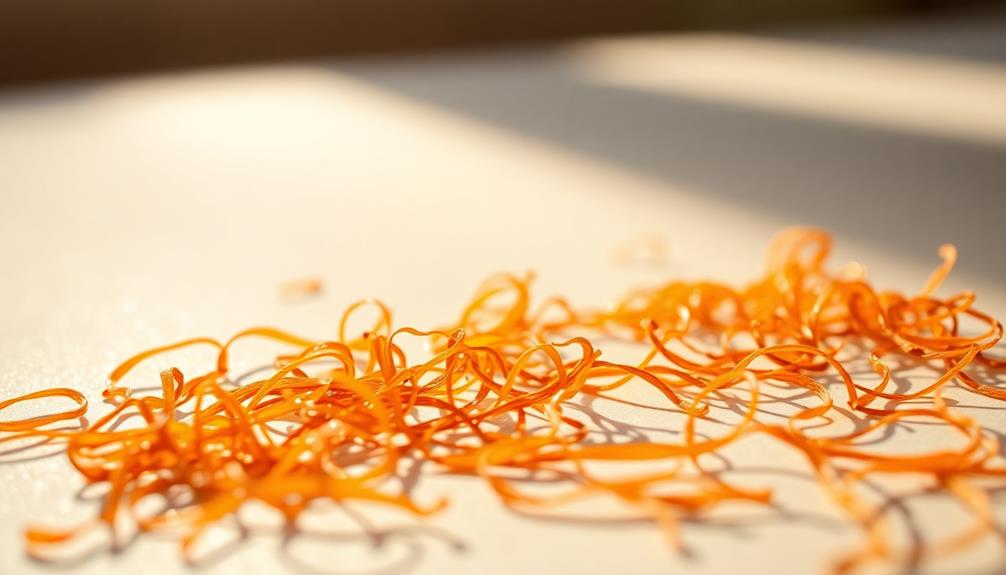
Once the saffron stigmas have been delicately harvested, you'll need to dry them in the sunlight. This process is crucial, as it preserves the spice's vibrant color, aroma, and flavor.
Spread the stigmas out on a clean, flat surface, ensuring they're not overlapping. Position the tray in a spot that receives ample direct sunlight, typically for 2-3 hours. Rotate the stigmas occasionally to ensure even drying. The stigmas should lose their moisture and become brittle, indicating they're ready for the next step.
Avoid exposing the stigmas to direct heat, as this can damage their delicate properties. Carefully monitor the drying process, as saffron is a precious and labor-intensive spice.
Once dried, store the saffron stigmas in an airtight container in a cool, dark place until you're ready to use them. Proper drying is essential to maintain the spice's distinctive characteristics and ensures you get the most out of your saffron.
Step 3. Roast Saffron Stigmas Gently
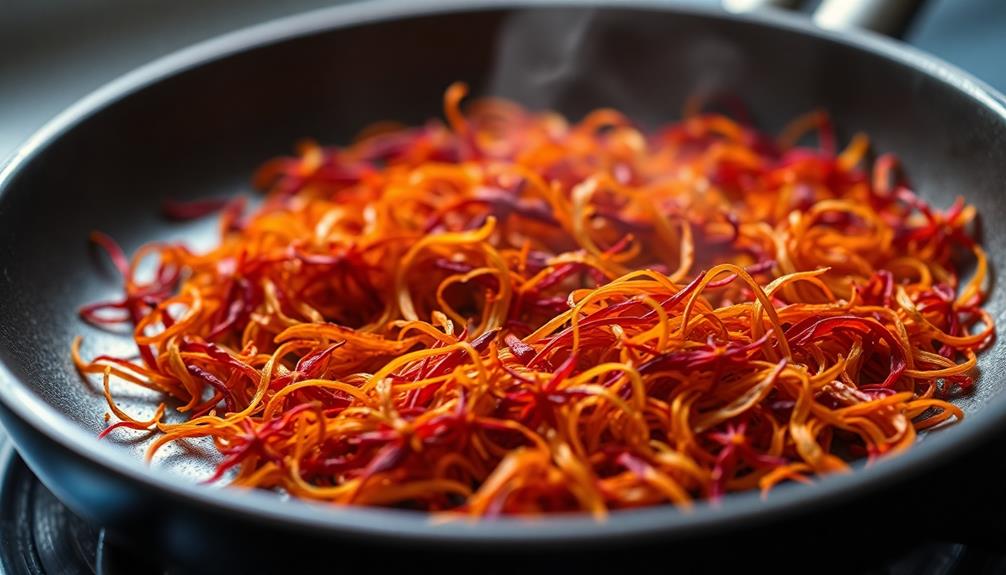
Gently roasting the dried saffron stigmas is the next crucial step in unlocking their full flavor potential.
Begin by heating a small, dry skillet over medium-low heat. Add the saffron stigmas in a single layer, taking care not to overcrowd the pan. Gently move the stigmas around with a spatula, ensuring they're evenly exposed to the heat.
You'll know they're done when they've darkened slightly and released their fragrant aroma, which should take no more than 2-3 minutes. Be cautious not to burn them, as this can impart a bitter, unpleasant flavor.
Once roasted, transfer the saffron to a clean, dry surface to cool completely before using. This delicate process concentrates the saffron's distinct flavors and aromas, making it a vital step in preparing this precious spice.
With the saffron stigmas roasted to perfection, you're now ready to incorporate them into your culinary creations.
Step 4. Steep Saffron in Hot Water
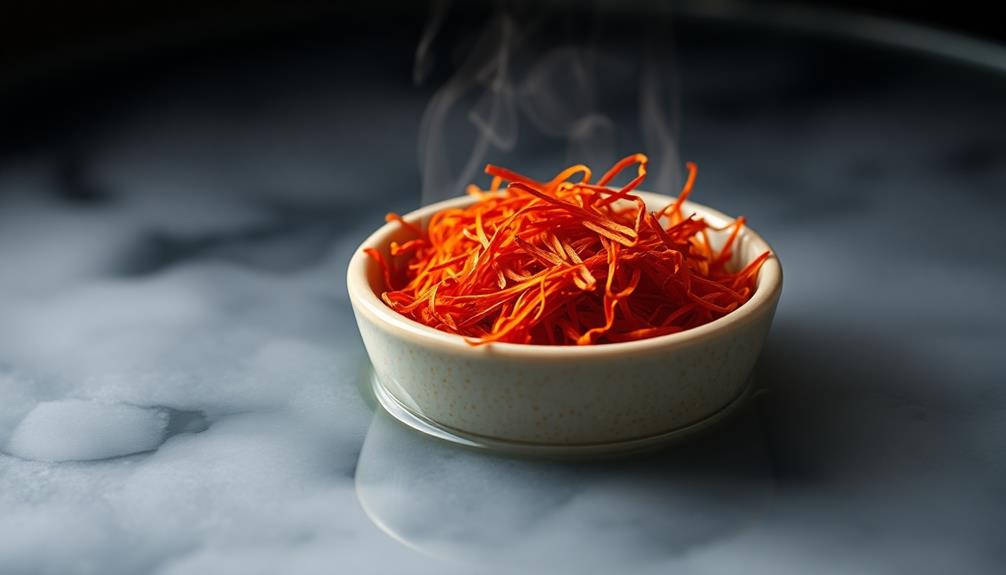
Next, you'll want to steep the roasted saffron stigmas in hot water.
Bring a small saucepan of filtered water to a gentle simmer, then remove it from the heat. Add the saffron threads and let them steep for 15-20 minutes, stirring occasionally. This process will extract the flavorful compounds and vibrant color from the saffron.
Once the saffron has steeped, strain the liquid through a fine-mesh sieve, reserving the precious saffron-infused water. The saffron threads can be discarded or saved for another use.
The strained liquid should have a deep, rich orange-red hue. This saffron-infused water is now ready to be used in your recipe, whether it's a risotto, paella, or any other dish that calls for the unique flavor and aroma of saffron.
The longer you steep the saffron, the more intense the color and flavor will become, so adjust the steeping time to suit your preferences.
Step 5. Use Saffron in Recipe
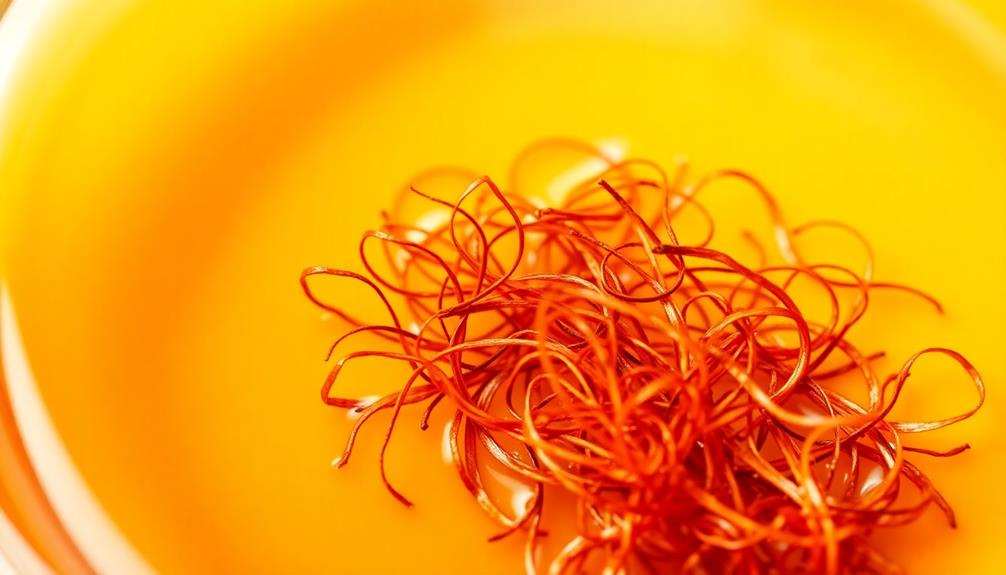
With the saffron-infused water ready, you can now start incorporating it into your recipe. Drizzle a few strands of saffron and a couple of tablespoons of the vibrant liquid into your dish, whether it's a risotto, paella, or even a baked good. The saffron will lend its distinct flavor and beautiful golden hue, transforming the dish into a culinary masterpiece.
When adding saffron, be mindful of the recommended amount, as a little goes a long way. Adjust the quantity to suit your personal taste preferences and the size of your recipe. Saffron's delicate nature means it can easily be overpowered by other strong flavors, so balance is key.
As the dish cooks, the saffron will infuse its essence, creating a harmonious blend of aromas and tastes.
Don't be afraid to experiment with saffron in both savory and sweet preparations. Its versatility allows it to elevate a wide range of dishes, from fragrant rice dishes to decadent desserts. Embrace the power of this precious spice and let its magic shine through in your culinary creations. For a simple and impressive way to incorporate saffron into your dessert repertoire, try using it in a fresh fruit galette recipe. The delicate, floral notes of the saffron will complement the natural sweetness of the fruit and add a beautiful golden hue to the pastry. Whether you’re a seasoned chef or a home cook looking to expand your culinary horizons, saffron is a wonderful addition to any kitchen. Get creative and discover all the ways you can work this exotic spice into your cooking.
Final Thoughts
While saffron may be the world's most expensive spice, its unique flavor and aroma make it a worthy investment for any culinary enthusiast. The delicate threads of this vibrant red spice can transform a simple dish into something extraordinary.
Whether you're infusing it into a risotto, baking it into a decadent dessert, or simply using it to add a touch of elegance to your plate, saffron's versatility knows no bounds.
Though the cost may deter some, a little goes a long way, and the rewards of cooking with this precious ingredient are well worth the investment.
As you explore the world of saffron, don't be afraid to experiment and discover new ways to incorporate it into your culinary creations.
With its unparalleled flavor and aroma, saffron is a spice that will undoubtedly elevate your cooking to new heights. Embrace the opulence and indulge in the magic of this extraordinary spice.
Frequently Asked Questions
How Is Saffron Harvested and Processed?
To harvest saffron, you must carefully pick the vibrant red stigmas from the purple crocus flowers by hand. The stigmas are then dried and processed to produce the coveted and prized saffron spice.
What Are the Health Benefits of Consuming Saffron?
Consuming saffron provides numerous health benefits. It can enhance your mood, improve your vision, and protect your heart. Additionally, it may help manage menstrual cramps and diabetes. Incorporating this vibrant spice into your diet is a simple way to boost your well-being.
How Can I Identify High-Quality Saffron?
To identify high-quality saffron, look for deep red stigmas that are long, thick, and flexible. Authentic saffron should have a strong, floral aroma and impart a vivid yellow color when steeped in water. Avoid saffron that's pale or brittle.
Can Saffron Be Used in Other Dishes Besides Food?
Absolutely! Saffron isn't just for culinary use. You can utilize its vibrant color and distinct aroma in various non-food applications, such as in textiles, cosmetics, and even traditional medicine. Explore saffron's versatility beyond the kitchen.
How Long Does Saffron Last and How Should It Be Stored?
Saffron's shelf life can last up to 2 years if you store it properly. Keep it in an airtight container in a cool, dark place, and you'll enjoy its vibrant flavor and aroma for a long time.
